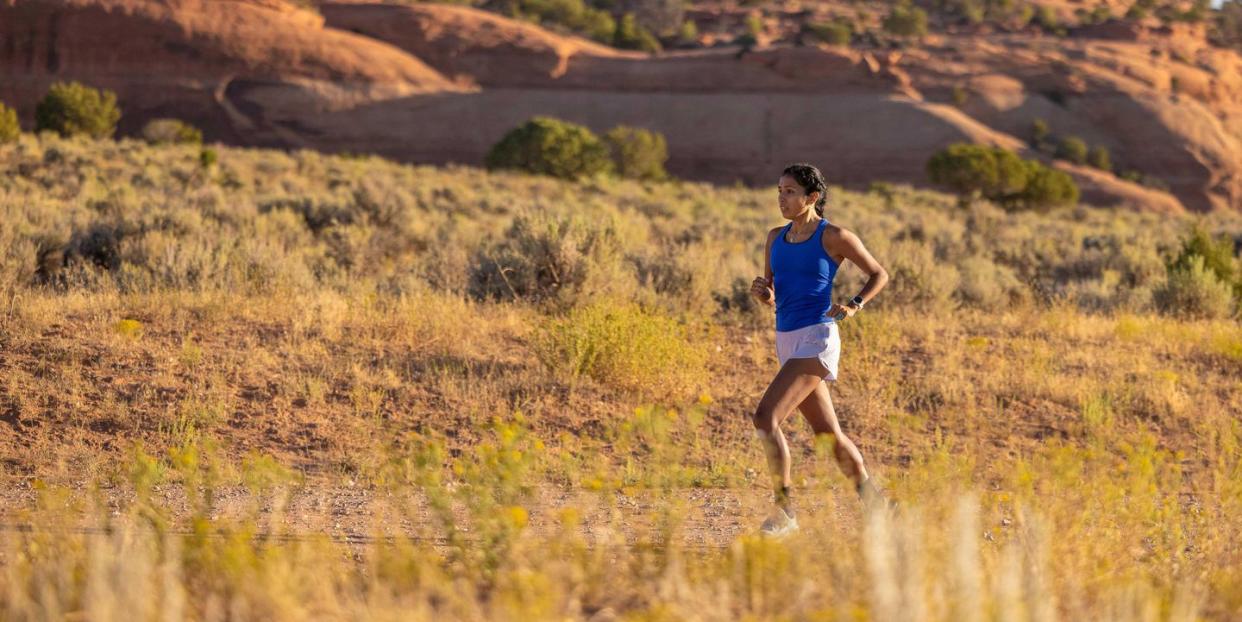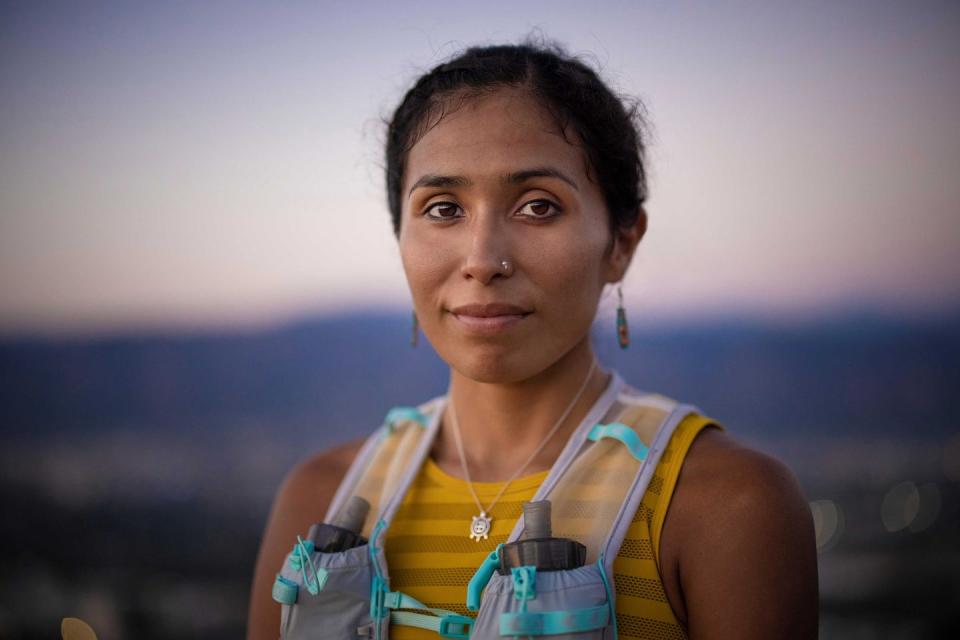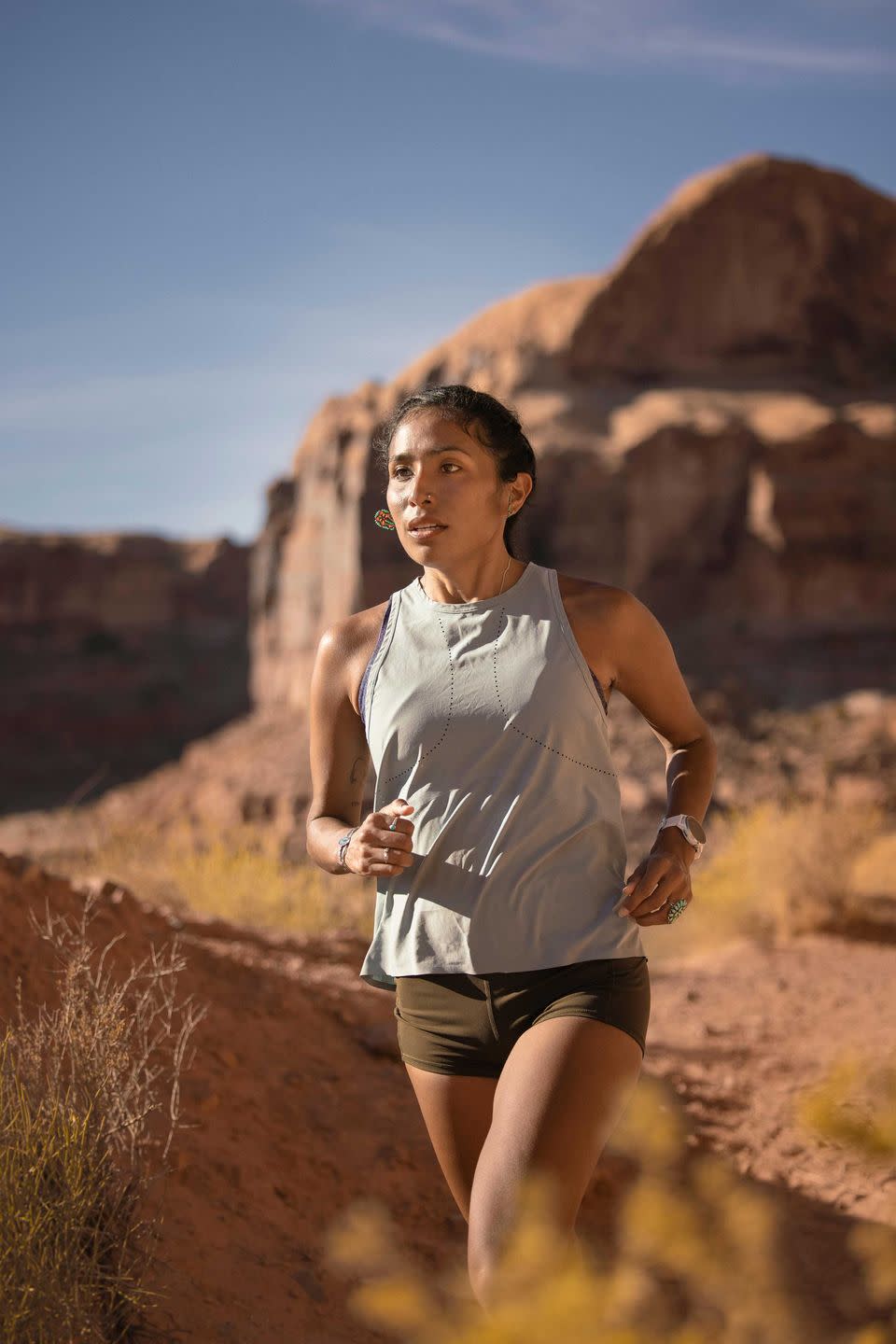This Marathoner Is Fighting for Missing and Murdered Indigenous Women

Jordan Marie Brings Three White Horses Daniel is an advocate for Indigenous rights. Daniel brought the Missing and Murdered Indigenous Women (MMIW) movement to the attention of the global running community when she ran the 2019 Boston Marathon with a red painted handprint over her mouth to represent the women silenced by violence, and the letters MMIW painted on her body. Every mile, Daniel said a prayer for a different Indigenous woman or girl affected by the MMIW epidemic—26 in all.
In the last year and a half, the Kul Wičasa Lakota runner who is based in Los Angeles has dedicated more than 100 miles to missing or murdered Indigenous women, girls, two spirit, and relatives. [Ed. Note: Two spirit refers to people who occupy an alternative gender status outside of man or woman.] Since Boston, Daniel has also encouraged allies to support organizations dedicated to the cause, and she is creating more educational awareness initiatives. Now Daniel is bringing her expertise to the Runners Alliance.

RUNNER'S WORLD: Why are your advocacy efforts important to you?
DANIEL: Advocating for missing and murdered Indigenous women, girls, two spirits, and our relatives is important because it's an epidemic happening to every Indigenous community, whether that's on the reservation, urban, or rural. And it's an epidemic and a heartbreak that expands beyond colonial borders and that's happening all over the world.
Advocating for the intersectionality across all of our movements just proves that everything is interconnected. They are all related. You can't have racial justice without climate justice. You can't have social justice without economic justice. Fighting for transformational change and equity; fighting for equality and visibility and respect, it's all connected. It also ensures that those coming from the BIPOC, the two spirit, LGBTQ, and non-binary community are heard and part of these conversations.
What led you to become an advocate for these causes?
As a Lakota woman, I've been inspired since I was little to be an advocate for my people, fighting for our next generations, and fighting for a better future. And as I've grown up and have learned more about what is happening, not just within Indigenous communities, but within Black, immigrant, and LGBTQ+ communities, it's become more apparent now that we are pinned up against systemic oppression that's created by white supremacy and racism. Over the last several years, I've been doing my own education to keep learning how this is keeping us divided, keeping us oppressed, keeping us from these opportunities, and keeping us from justice.
I believe we can have a better world that is more inclusive and diverse and more supportive. And I think we're starting to see this transformational change and multiracial movement just beginning to dismantle white supremacy and racism, rebuilding a better future.
What is your ultimate goal with your advocacy work?
My ultimate goal is to create a better and safer future where especially Indigenous folks, but also everyone coming from the BIPOC, LGBTQ+, two spirit, non-binary community is seen and represented, respected, and has these opportunities to speak on these platforms and be part of these conversations, to have a seat at the table. That's the work that I'm most passionate about. It's paving these pathways and these opportunities with other amazing and inspiring voices and leaders in our communities to make this happen.
What does running mean to you? How do you think running helps you in your advocacy work and in reaching the community you're serving?
Running has always connected me with my family. I'm a fourth-generation runner and it's this family legacy that I thought was so cool to be part of and to share in that history with my grandfather and my mom.
I love the community that running has. Whether you're Olympic status or someone who gets out for a run once a week, the community that it creates and brings together, in my experience, has been so supportive.
In recent years, I've been participating in prayer runs, but it never occurred to me to connect [prayer runs and racing]. I always kept them compartmentalized from each other. And then it got to the point where enough was enough. Having no visibility and attention for the epidemic of MMIW was just heartbreaking. It felt exhausting that so much work was going into this movement to find answers and solutions and justice, and it still was not getting any sort of attention. No one cared about the deaths and murders and disappearances of Indigenous women and our relatives. That's where I took that opportunity to run in prayer, to run for them rather than for me. Running has always been a team sport but a selfish sport in a sense, because I've always trained to run fast, to hit these times to place very well. But when it came to the 2019 Boston Marathon, it was just at that point where I didn't care what I did that day. I just wanted to cross the finish line with those 26 prayers said and lifted.
That transformed into running for justice, what I'm committed to doing now, to keep spreading this message and to keep raising awareness, to bring allies, to get everyone to support those that have been doing this work for decades, to support the families who have loved ones missing or murdered, and to continue this ongoing conversation and to paint the message clear that there are dangers and targets for Indigenous women and Black women, especially, and folks of color. What we saw with Ahmaud Arbery, that raises another question in the conversation of what runner safety looks like for us now, especially those coming from the BIPOC and LGBTQ, two spirit, non-binary communities. I think that needs to be included in these discussions.
My hopes are to not only continue this awareness, but develop solutions or ideas, something creative and innovative where we can make running safe for us. We need to make sure that we have systems, procedures, policies, laws or technology in place that can protect us.

What made you decide to join the Runners Alliance ambassador program?
The opportunity to continue this visibility and platform to include a diverse group of voices and experiences. I think it's going to be incredible to have these discussions with other folks coming from their own communities so I can continue my education and learn how to be a better friend and relative and runner and community member, but also to share my experiences and hope that educates other folks that are part of this ambassador program. It creates this opportunity to continue doing good work to create a better and safer environment for the communities that we care so much about.
What are your hopes for the Runners Alliance?
I hope this alliance can create some form of actionable and proactive items and measures not just for us on the ambassador program, but something that we can create for the runners community to take a pledge to taking action into creating a safer environment and world for every runner.

You Might Also Like

